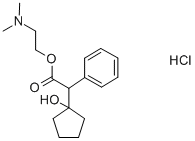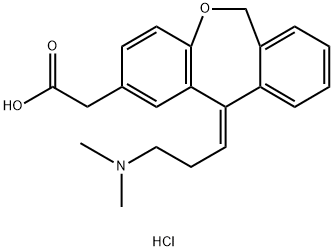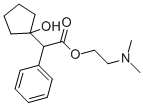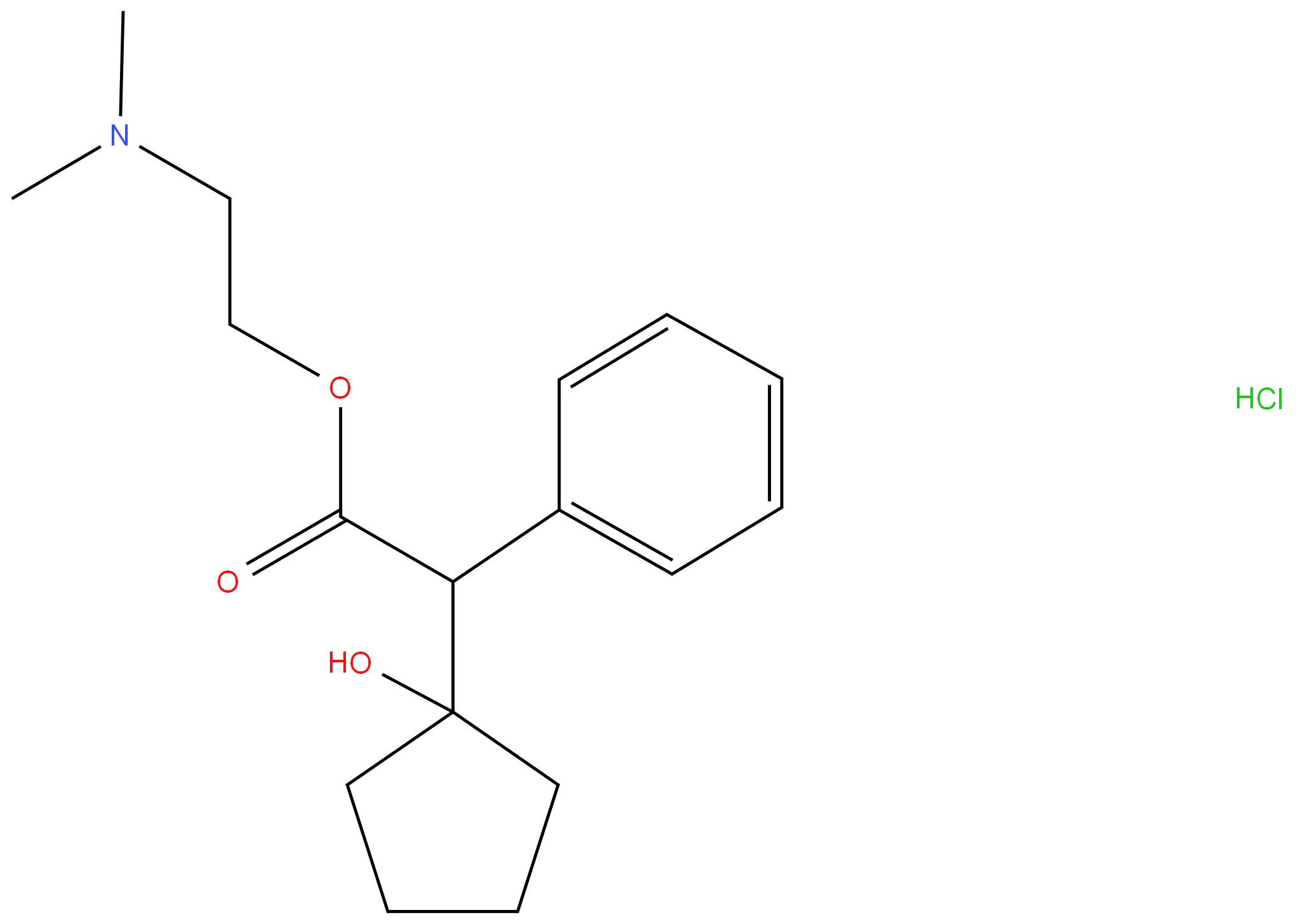CYCLOPENTOLATE HYDROCHLORIDE
Synonym(s):2-Dimethylaminoethyl 1-hydroxy-α-phenylcyclopentaneacetate
- CAS NO.:5870-29-1
- Empirical Formula: C17H26ClNO3
- Molecular Weight: 327.85
- MDL number: MFCD00079048
- EINECS: 227-521-8
- SAFETY DATA SHEET (SDS)
- Update Date: 2025-01-27 09:38:02

What is CYCLOPENTOLATE HYDROCHLORIDE?
Description
Cyclopentolate is an antagonist of muscarinic acetylcholine receptors (Kis = 1.62, 27.5, and 2.63 nM for M1, M2, and M3 receptors, respectively). It inhibits carbachol-induced contraction of isolated human iris sphincter, circular ciliary muscle, and longitudinal ciliary muscle (Kbs = 7.9, 15.8, and 12.5 nM, respectively). Formulations containing cyclopentolate have been used to induce pupil dilation and to prevent the eye from accommodating for near vision.
Chemical properties
White Solid
Originator
Cyclogyl,Schieffelin,US,1953
The Uses of CYCLOPENTOLATE HYDROCHLORIDE
Mydriatic;Cholinergic receptor antagonist
The Uses of CYCLOPENTOLATE HYDROCHLORIDE
antiviral
The Uses of CYCLOPENTOLATE HYDROCHLORIDE
antitussive
The Uses of CYCLOPENTOLATE HYDROCHLORIDE
A mydriatic
What are the applications of Application
Cyclopentolate Hydrochloride is a mydriatic
Definition
ChEBI: Cyclopentolate hydrochloride is the hydrochloride salt of cyclopentolate. It is used to produce mydriasis (excessive dilation of the pupil) and cycloplegia (paralysis of the ciliary muscle of the eye) for opthalmic diagnostic procedures. It acts more quickly than atropine and has a shorter duration of action. It has a role as a mydriatic agent, a parasympatholytic, a diagnostic agent and a muscarinic antagonist. It contains a cyclopentolate.
Manufacturing Process
To a well stirred suspension of 9 g of sodium phenyl acetate and 2.4 g of
magnesium turnings in 25 cc of anhydrous ether, a solution of 9.4 cc of
isopropyl bromide in 50 cc of anhydrous ether are added. The mixture is
refluxed for one hour (during which time propane is evolved) and then 5 cc of
cyclopentanone in 25 cc of anhydrous ether are added dropwise. The mixture
is then refluxed for one hour and poured over ice water containing some
hydrochloric acid. The ether solution is separated and extracted with 200 cc of
5% sodium hydroxide. The alkaline solution on acidification gives the free acid which is filtered off, dried in a desiccator and recrystallized from a mixture of
ethylene dichloride and petroleum ether.
The product is 2-phenyl-2-(1-hydroxycyclopentyl)ethanoic acid, melting at 95°
to 97°C. Of this product, 4.5 g in 30 cc of dry isopropyl alcohol are refluxed
for 16 hours with 2.5 g of β-chloroethyl dimethyl amine. The solution is cooled
and filtered clear from the solid by-product. The solvent is removed under
reduced pressure on the steam bath and the residue is washed with
anhydrous ether. It is dissolved in ethyl acetate from which it crystallizes. It is
the hydrochloride of β-(dimethylamino)ethyl ester of 2-phenyl-2-(1-
hydroxycyclopentyl) ethanoic acid, melting at 134° to 136°C.
brand name
Akpentolate (Akorn); Cyclogyl (Alcon); Pentolair (Bausch & Lomb); Pentolair (Pharmafair).
Therapeutic Function
Anticholinergic (ophthalmic)
General Description
Cyclopentolatehydrochloride, 2-dimethylaminoethyl 1-hydroxy- -phenylcyclopentaneacetatehydrochloride (Cyclogyl), is a crystalline,white, odorless solid that is very soluble in water,easily soluble in alcohol, and only slightly soluble in ether.A 1% solution has a pH of 5.0 to 5.4.
Cyclopentolate hydrochloride has one half of the antispasmodicactivity of atropine and is nonirritating when instilledrepeatedly into the eye. If not neutralized after the refractionstudies, its effect dissipates within 24 hours. Neutralizationwith a few drops of pilocarpine nitrate solution, 1% to 2%,often results in complete recovery in 6 hours. It is supplied asa ready-made ophthalmic solution in concentrations of either0.5% or 2%.
Clinical Use
Cyclopentolate Hydrochloride is used only for its effects on the eye, where it acts asa parasympatholytic. When placed in the eye, it quickly producescycloplegia and mydriasis. Its primary field of usefulnessis in refraction studies. Cyclopentolate hydrochloridecan be used, however, as a mydriatic in the management ofiritis, iridocyclitis, keratitis, and choroiditis. Although itdoes not seem to affect intraocular tension significantly, it isbest to be very cautious with patients with high intraocularpressure and with elderly patients with possible unrecognizedglaucomatous changes.
Properties of CYCLOPENTOLATE HYDROCHLORIDE
| Melting point: | 137-141° |
| storage temp. | Inert atmosphere,Room Temperature |
| solubility | Very soluble in water, freely soluble in ethanol (96 per cent). It shows polymorphism (5.9). |
| form | neat |
| form | Solid |
| color | White to Off-White |
Safety information for CYCLOPENTOLATE HYDROCHLORIDE
Computed Descriptors for CYCLOPENTOLATE HYDROCHLORIDE
CYCLOPENTOLATE HYDROCHLORIDE manufacturer
Festiva Pharma
New Products
2-Propanamine, 1-chloro-, hydrochloride (9CI) 3-Pyridineacetonitrile, α-hydroxy- 3-Iodophenylacetic acid 3-(hexyloxy)-4-(pyridin-3-yl)-1,2,5-thiadiazole 2-Hexyn-1-ol Dibenzo-18-crown-6 Strontium Carbonate, 98% Wang resin Sodium hydrogenphosphate, anhydrous 2-Bromo-3-methoxyaniline hydrochloride, 95% (Custom work) 1-Bromo-4-chlorobenzene, 99% Benzocaine, 98% (R)-2-Methylpyrolidine-2-carboxylic acid (De Mepro) Ramipril Sacubitril- Valsartan Boc-his(trt)-OH Fmoc-L-Glu-OtBu Boc-L-Tyr(tBu)-OH N N Dimethylformamide Dimethyl Acetal (Dmf Dma) Semi carbazide Hydrochloride 1-Ethyl-3-(3-Dimethylaminopropyl)-Carbodiimide Hydrochloride [EDC Hcl] 5-(Difluoromethoxy)-2-Mercaptobenzimidazole Trans-4-Aminocyclohexanol [4tac] 2-Chloromethyl-4-methyl-quinazolineRelated products of tetrahydrofuran








You may like
-
 5870-29-1 Cyclopentolate Hydrochloride 98%View Details
5870-29-1 Cyclopentolate Hydrochloride 98%View Details
5870-29-1 -
 5870-29-1 98%View Details
5870-29-1 98%View Details
5870-29-1 -
 5870-29-1 Cyclopentolate hydrochloride 99%View Details
5870-29-1 Cyclopentolate hydrochloride 99%View Details
5870-29-1 -
 Cyclopentolate Hydrochloride 99%View Details
Cyclopentolate Hydrochloride 99%View Details
5870-29-1 -
 Cyclopentolate hydrochloride 98%View Details
Cyclopentolate hydrochloride 98%View Details
5870-29-1 -
 Cyclopentolate hydrochloride 5870-29-1 98%View Details
Cyclopentolate hydrochloride 5870-29-1 98%View Details
5870-29-1 -
 Cyclopentolate HCl 98% CAS 5870-29-1View Details
Cyclopentolate HCl 98% CAS 5870-29-1View Details
5870-29-1 -
 Cyclopentolate hydrochloride CAS 5870-29-1View Details
Cyclopentolate hydrochloride CAS 5870-29-1View Details
5870-29-1
